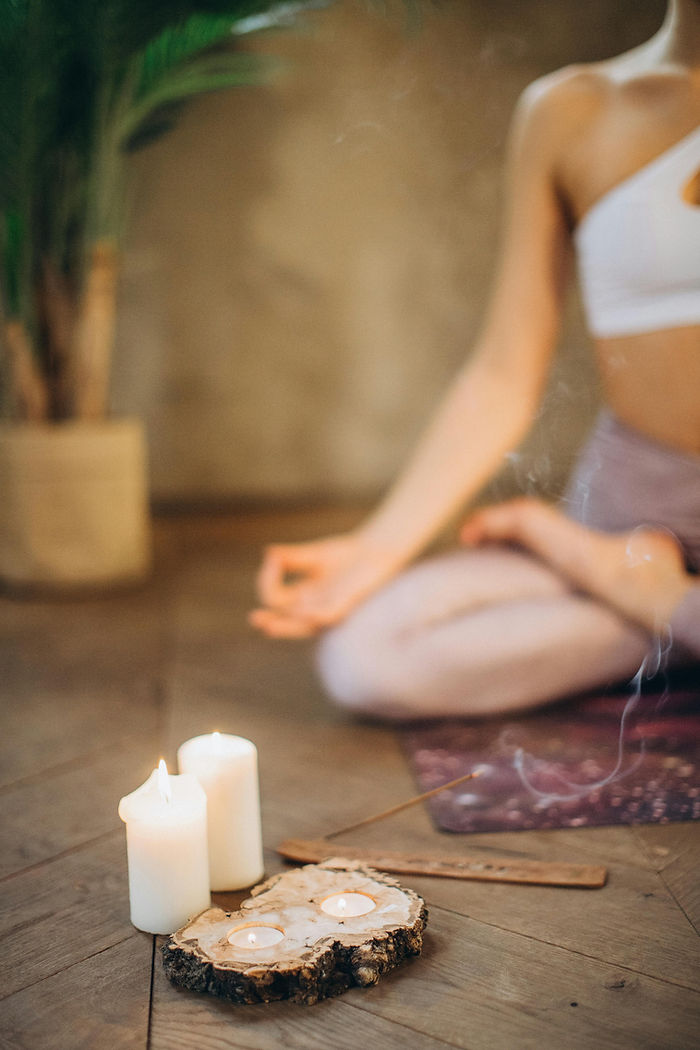
Creator and founder of breath~breaks. Discovered breath breaks after 7+ years of trying to integrate mindful practices into daily life.
In our fast-paced world, stress has become an all-too-familiar companion – nearly half of U.S. adults (about 45%) report feeling stressed regularly.
To cope, many people turn to meditation, and its popularity has skyrocketed (the number of American adults practicing meditation tripled in the last decade (thegoodbody.com). Meditation is now one of the most popular mind-body practices for wellness. But let's be honest: traditional meditation doesn't work for everyone. Sitting still and clearing your mind can feel impossible when you’re anxious, busy, or simply not wired for it. The good news is you don’t have to meditate to reap the benefits of mindfulness (ableto.com). There are meditation alternatives that help you cultivate calm, focus, and self-awareness – no pretzel-twisting yoga poses or hours on a cushion required.
In this post, we’ll explore why mindfulness is bigger than meditation alone, introduce powerful alternatives like breath breaks, mindful walking, and journaling, and also acknowledge why meditation is still worth a try (backed by science!). By the end, you’ll see that while you don’t have to meditate to live mindfully, you’ll probably want to once you understand the benefits. Let’s dive in.

Mindfulness beyond meditation: The concept of "non-meditation"
What if being mindful could be as simple as paying attention to your life, without formal meditation at all?
Mindfulness is about being present in the moment, and it’s not confined to sitting on a cushion. As famed mindfulness teacher Jon Kabat-Zinn reminds us, “The real meditation is how you live your life.” (tinybuddha.com). In other words, the true spirit of meditation is found in everyday awareness – often called “informal practice” or even “non-meditation”. Non-meditation means cultivating mindfulness through ordinary activities rather than a formal meditation session.
“The real meditation is how you live your life.” ~ Jon Kabat-Zinn
Think about it ~ anytime you bring full attention to the here and now, you are practicing mindfulness. This could be noticing the warmth of the water and the scent of the soap while washing dishes, or feeling your feet hitting the ground one step at a time during a walk. You don’t need to chant “Om” or sit cross-legged to tune into the present.
Everyday moments can become mini meditations. For those who find it hard to sit still or “empty the mind,” this is liberating. Mindfulness is a way of being, not just an activity you do for 10 minutes in the morning. By discovering mindfulness in daily life – what some might call non-meditation practice – you realise that you can be centred and calm without ever formally meditating. It’s the mindset of presence that matters.
Embracing mindfulness beyond meditation also removes the pressure of doing it “right.” There’s no need to judge yourself for a wandering mind in a meditation session. Instead, you learn to carry a gentle awareness into whatever you’re doing. This approach is motivating and grounding: it means anyone can access mindfulness, whether or not you’re a “meditator.” And paradoxically, once you start living more mindfully, you may become curious about formal meditation because you’ve already experienced its core essence. The bottom line is, you have permission to approach mindfulness in the way that best fits your life – even if that means mindful living without classic meditating.
The proven benefits of meditation (why you probably should try it)
So, if you don’t have to meditate, why does every wellness expert still recommend it? The answer: because it works. Decades of research show that meditation (especially mindfulness meditation) can profoundly benefit both mind and body.
Even if you explore alternatives, there’s a reason meditation is often called a “practice worth practicing.” Let’s look at a few science-backed highlights:
- Stress and Anxiety Reduction: Meditation is well-known for calming the nervous system. In fact, a recent clinical trial found that an 8-week mindfulness program reduced anxiety symptoms by about 20%, rivaling the effects of a common anti-anxiety medication (Lexapro) (npr.org). Another study in 2022 showed mindfulness meditation can decrease anxiety levels by around 30% in two months – making it as effective as a standard drug treatment for anxiety (golemanei.com).
- Emotional Well-Being and Focus: Regular meditation practice is linked to improved mood, greater emotional resilience, and better focus. By training you to observe thoughts and feelings without getting caught up in them, meditation builds an inner calm and non-reactivity. Neuroscientists have even observed changes in the brain: areas associated with stress may shrink, while areas tied to attention and empathy grow with consistent meditation. As Dr. Andrew Huberman (Stanford neuroscientist) points out, “Mindfulness practices like meditation and deep breathing can help rewire the brain and reduce stress.” (hugojorge.com). Your brain is plastic, and meditation is one tool to shape it for the better.

“Mindfulness practices like meditation and deep breathing can help rewire the brain and reduce stress.” ~ Dr. Andrew Huberman
- Physical Health Perks: The mind-body benefits of meditation extend into physical health. For example, research has found that people who meditate can reduce their risk of heart disease – one study showed an 87% lower chance of hospitalization for heart disease among meditators (thegoodbody.com). Meditation may also strengthen the immune system and reduce inflammation in the body. And if you’ve ever struggled with sleep, meditation might help; many find that a calmer mind translates to better sleep quality.
Given these benefits, it’s clear why we’d say you “probably should” meditate – who wouldn’t want less stress, a happier mood, and a healthier body? Even a few minutes a day can make a difference. It’s also low-cost and accessible. If it feels challenging at first, remember that it’s called a practice for a reason. You can start small (even 2-5 minutes) and build up.
The science is encouraging, but ultimately, it’s about how you feel. Many find that over time, meditation shifts their baseline to a more centred, content place.
Meditation alternatives: How to be mindful without meditating
What are the alternatives to meditation? Fortunately, there are many enjoyable ways to cultivate mindfulness and reduce stress without sitting in formal meditation. Here are a few evidence-backed meditation alternatives to consider, and how to practice them:
- Taking “breath breaks”: One of the simplest alternatives is a short breathing exercise – essentially a mini mindfulness session anchored in the breath. For instance, you can pause for one minute, close your eyes, and take slow, deep breaths. This small act helps trigger your body’s relaxation response. Even just 60 seconds of conscious breathing can pull you out of fight-or-flight mode and into a calmer state. We call this a “breath break,” and it’s arguably the most effortless way to inject mindfulness into your day.
- See our post on what a breath break is for guidance: What is a breath break ~ And why you need it?
- Mindful Walking: If sitting still isn’t for you, try walking – mindfully. Mindful walking (sometimes called walking meditation) means you deliberately pay attention to the experience of walking. Feel your feet contacting the ground with each step, notice the rhythm of your breath as you move, and observe the surroundings with fresh eyes. This practice turns an ordinary walk into a calming, centering experience. It’s also a great stress-buster. In fact, studies indicate that mindful walking can reduce stress, lower blood pressure and heart rate, improve mood, and even lead to better sleep (canr.msu.edu).
- Journaling (Mindful Writing): Another excellent mindfulness alternative is journaling. Taking pen to paper and writing down your thoughts or feelings can be deeply therapeutic and grounding. The act of journaling forces you to slow down and reflect, which is inherently mindful. You might write about what you’re grateful for, process a stressful event, or simply do a stream-of-consciousness “brain dump.” Research suggests that expressive writing and journaling can reduce stress, improve mood, and even strengthen immune function (greatergood.berkeley.edu). It helps you process emotions rather than suppress them.
- Everyday Activities Done Mindfully: Finally, remember that any activity can be done mindfully. This is the essence of “how to be mindful without meditating.” You can practice mindful eating by truly savouring your food (notice the textures, flavours, and aromas with each bite, without distraction). You can have a mindful cup of tea or coffee or do some mindful cleaning. These might sound trivial, but they are profound in effect. When you infuse mindfulness into these small moments, you break the cycle of living on “autopilot.”
- Suddenly, your day has pockets of peace and clarity where before there was tension or mindlessness. Over time, this can dramatically reduce overall stress. So, try picking one daily activity and do it with 100% presence. You’ll likely find even mundane moments become richer and more rewarding.
Each of these meditation alternatives shows that you can cultivate mindfulness anywhere, anytime. Whether it’s a one-minute breath break between meetings, a quiet mindful walk at lunch, jotting down your thoughts at night, or simply being fully present during a routine task – you are reaping many of the benefits of meditation without formally meditating. Mindfulness is a custom-fit practice, so feel free to experiment with these alternatives and find what resonates with you.
Finding What Works for You: Is Anything More Powerful Than Meditation?
You might wonder, “Okay, but is there something that’s even more powerful than meditation for improving my well-being?” The truth is, there’s no one-size-fits-all answer. Meditation is a powerful tool, but the “most powerful” practice is ultimately the one you will stick with and enjoy.
That said, meditation often addresses things those other practices don’t. It trains your mind in awareness and compassion in a unique way. Instead of asking what is more powerful than meditation, it may be better to ask: what complements meditation, or what works best for my needs?
Ultimately, rather than declaring one approach “more powerful” than another, it’s wise to have a toolbox. On days when you have the energy and time, you might do a 20-minute meditation. On hectic days, maybe a couple of breath breaks or a mindful walk is all you need. Some days, laughter with friends or time in nature might be the best medicine for your mind. All these paths can lead toward greater mindfulness and well-being. The key is to listen to yourself. Notice what makes you feel grounded, present, and alive. Those are your mindfulness allies. The goal is to develop your own toolbox of habits that can be used depending on your internal and external situation.
How breath~breaks™️ can help
If you found these insights helpful, consider subscribing to our updates.
Join our community of mindfulness enthusiasts – no meditation cushion required – and get fresh inspiration delivered to your inbox. Remember, the present moment is always here for you to return to. Breathe deep, stay curious, and be well.
.png)

%402x%20(2).svg)






